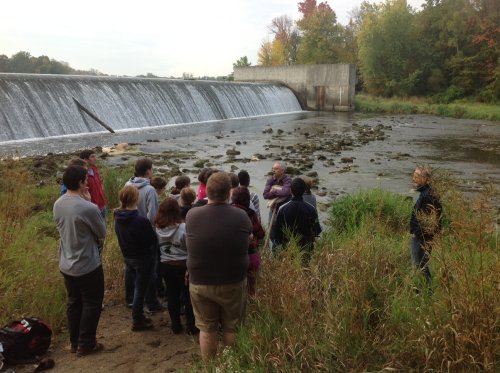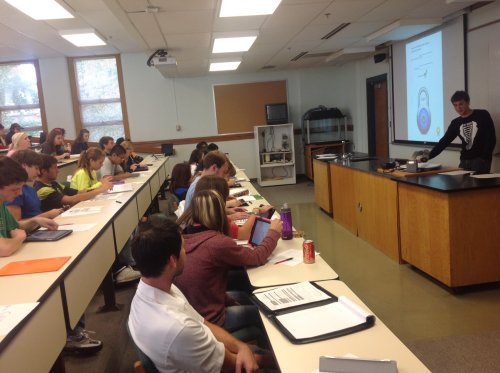A few posts back I offered a sneak preview of GainSeeker Collect, our new mobile app. Today I got to see it being (literally) field tested in one of the most unusual applications imaginable.
I want to be quick to say that GainSeeker Connect is designed to collect quality data for our manufacturing customers; we’re not trying to shift to the academic market. But the new app is so powerful and flexible that it is finding a home in a college freshmen environmental biology class.
So today I took a little field trip: I drove 10 minutes from our office to the banks of the Elkhart River. There I watched a bunch of college students collect water quality data to load into GainSeeker Suite. Instead of putting on hearing protection and safety glasses, I got my shoes muddy, watched geese fly over, and listened to Goshen College Biology Professor, Ryan Sensenig, explain the Hoosier River Watch protocol for water sampling. Here are the students and Professor Sensenig.
How I landed on this river bank is an interesting story. It began two or three years ago when some local environmentalists began collecting water quality data and approached area businesses to sponsor bulletin boards to communicate their findings to the community. Since I kayak on this river, and since our business is helping people turn data into knowledge, I offered to take it a step further and assemble their data on our website.
Over the next few years we started collecting data, and publishing it on our site. (You can get to this data by clicking here and logging in with a username of CCWP and no password. Poke around to see WebViz, our web-based charting tool, in action.) But I didn’t give it a lot of time, we didn’t promote it, and not many people knew what to do with the charts.
Fast forward to this summer. We had hired a summer intern to help us develop the beta version of GS Collect, a new data entry module for mobile devices. We wanted to build something that had the flexibility to work in a wide variety of situations. It had to be customizable. While we were still in the early stages of this project, I had a conversation with Prof. Sensenig, and mentioned what we were working on. It was liking dropping water in a hot skillet. Ryan immediately saw the connections and the possibilities, and in a few minutes he formed a vision that connected his educational goals with our products and the community at large.
So here is what we’re working on:
Hertzler Systems donated licenses of GainSeeker Suite to Goshen College, and installed them on a college server. We custom-configured the mobile app to collect dozens of water quality indicators. Students download the app for free from the Apple Store, and configure it to point to their server, and have instant access to the checks for water quality. These checks include everything from chemical results to counts of invertebrate species. We consider this a kind of acid test for the app – if we can configure it to do this work, and turn a bunch of college freshmen loose on it, we think the new app can probably work in any situation our customers throw at us.
Here Jacob Shetler is introducing the biology class to the new GS Connect mobile app, earlier this week. Jacob developed the app during a summer internship with us.
So the new mobile app makes capturing this data and storing it in a database for analysis and reporting much easier.
But that is only one part of Ryan’s vision. Another important question, one that is perfectly aligned with Hertzler’s mission, is how do we share this data (that is, knowledge) with the broader community? Or to put it another way, how do we turn this data into knowledge?
To meet this objective, Ryan’s students will work in teams to propose a website design – a dashboard – that will report key metrics describing the health of the river to interested citizens. Their designs will be use data and statistics from GainSeeker Suite. They’ll present that proposal to us with a group of environmentalists early in November. We’ll select the winning design to be implemented the following semester by a team from the Goshen College Informatics Department.
This has been a fun project for all of us, and we’ve learned a lot about the mobile environment along the way. This effort makes us a better company, and will benefit our customers in ways that we probably don’t fully grasp. At a personal level, as a member of my local community, it feels great to participate in something that brings together town, gown, and business for the good of a community asset, our river.
How is mobile computing changing your life? Where might you use roving data collection and inspection? Use the ShareThis button below to mark this page, leave a comment, schedule a conversation, or call 800-958-2709.


